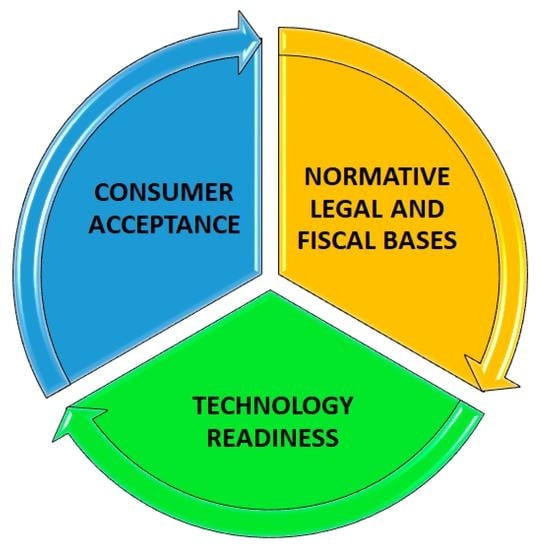Global Ban on Plastic and What Next? Are Consumers Ready to Replace Plastic with the Second-Generation Bioplastic? Results of the Snowball Sample Consumer Research in China, Western and Eastern Europe, North America and Brazil
Abstract
1. Introduction
- Bio-based or partially bio-based but non-biodegradable materials such as bio-based polyethylene (PE), polypropylene (PP) or poly(ethylene terephthalate) (PET) (so-called “drop-ins”) and bio-based technical performance polymers such as poly(trimethylene terephthalate) (PTT) or thermoplastic copolyester elastomer (TPC-ET);
- bio-based and biodegradable material, such as poly(lactic acid) (PLA), poly(hydroxyalkanoate) (PHA) and poly(butylene succinate) (PBS);
- fossil-based but biodegradable material, such as poly(butylene adipate terephthalate) (PBAT).
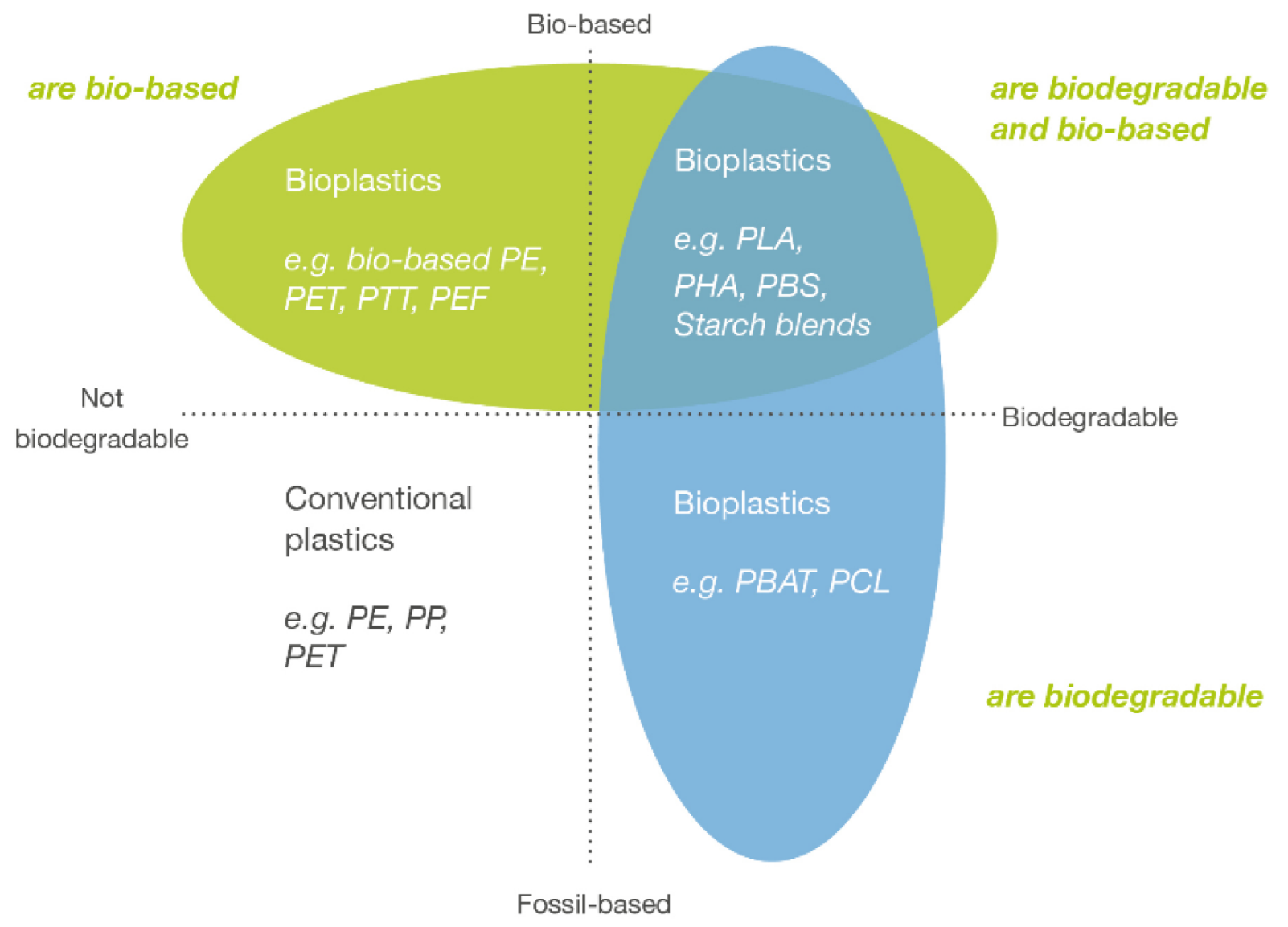
2. Material and Methods
Statistical Data Analysis
3. Results and Discussion
3.1. Legal Framework
3.1.1. European Union
3.1.2. Portugal
3.1.3. Poland
3.1.4. Ukraine
3.1.5. Brazil
3.1.6. USA
3.1.7. China
3.2. Consumer Acceptance for Alternatives to Single-Use Plastics in the Food and Beverage Sectors
3.2.1. European Union
3.2.2. Portugal
3.2.3. Poland
3.2.4. Ukraine
3.2.5. Brazil
3.2.6. USA
3.2.7. China
3.3. Online Survey Results
3.3.1. Characteristics of Questionees
3.3.2. Social Perception of Bioplastics
- Would you support replacing traditional plastic food packaging with bioplastic packaging?
- 2.
- Did you know that bioplastics can be made from leftovers of bakery and confectionery products (e.g., bread, cakes …)?
- 3.
- Would it bother you to know that the bioplastic packaging, in which the bread is wrapped, is made of bakery and confectionery leftovers?
- 4.
- Would you expect a clear notice on the bioplastic packaging that will allow you to choose between traditional plastic and biodegradable plastic?
- 5.
- How much more would you be able to pay for a product packed in bioplastic?
- 6.
- Did you know that bioplastic can extend the life of a product and preserve its visual and taste properties?
- 7.
- Would you share the knowledge about such packaging with others?
- 8.
- Would you encourage others to use modern, environmentally friendly packaging?
4. Conclusions
Author Contributions
Funding
Institutional Review Board Statement
Informed Consent Statement
Data Availability Statement
Conflicts of Interest
References
- United Nations. How do we #BeatPlasticPollution. 2021. Available online: https://www.un.org/pga/73/plastics/ (accessed on 23 September 2021).
- Fuhr, L.; Franklin, M. Plastic Atlas—Facts and Figures about the World of Synthetic Polymers, Heinrich Böll Foundation and Break Free from Plastic, Berlin, Germany. 2019. Available online: https://za.boell.org/en/2019/11/06/plastic-atlas-facts-and-figures-about-world-synthetic-polymers (accessed on 26 September 2021).
- Morone, P.; Yilan, G. A paradigm shift in sustainability: From lines to circles. Acta Innov. 2020, 36, 5–16. [Google Scholar] [CrossRef]
- Kochańska, E.; Łukasik, R.; Dzikuć, M. New Circular Challenges in the Development of Take-Away Food Packaging in the COVID-19 Period. Energies 2021, 14, 4705. [Google Scholar] [CrossRef]
- Endres, H.-J. Bioplastics. In Biorefineries; Springer: New York, NY, USA, 2017; Volume 166, pp. 427–468. [Google Scholar] [CrossRef]
- Abhilash, M.; Thomas, D. Biopolymers for Biocomposites and Chemical Sensor Applications. In Biopolymer Composites in Electronics; Elsevier Inc.: Amsterdam, The Netherlands, 2017. [Google Scholar] [CrossRef]
- European Bioplastics. 2021. Available online: https://www.european-bioplastics.org/ (accessed on 26 September 2021).
- European Bioplastics. What are Bioplastics? Material Types, Terminology, and Labels—An Introduction. 2018. Available online: https://www.european-bioplastics.org/bioplastics/ (accessed on 26 September 2021).
- Distaso, M. Potential contribution of nanotechnolgy to the circular economy of plastic materials. Acta Innov. 2020, 37, 57–66. [Google Scholar] [CrossRef]
- Bojarska, J.; Złoty, P.; Wolf, W.M. Life cycle assessment as tool for realization of sustainable development goals—Towards sustainable future of the world: Mini review. Acta Innov. 2021, 38, 49–61. [Google Scholar] [CrossRef]
- Lopes, T.F.; Łukasik, R.M. Economic, social and environmental impacts attained by the use of the effluents generated within a small-scale biorefinery concept. Acta Innov. 2020, 36, 57–63. [Google Scholar] [CrossRef]
- Parfitt, J.; Barthel, M.; Macnaughton, S. Food waste within food supply chains: Quantification and potential for change to 2050. Philos. Trans. R. Soc. B Biol. Sci. 2010, 365, 3065–3081. [Google Scholar] [CrossRef]
- European Commission. Farm to Fork Strategy. 2020, p. 23. Available online: https://ec.europa.eu/food/horizontal-topics/farm-fork-strategy_en (accessed on 30 September 2021).
- Barska, A.; Wyrwa, J. Konsument Wobec Opakowań Aktywnych I Inteligentnych Na Rynku Produktów Spożywczych. Probl. Agric. Econ. 2016, 349, 143–161. [Google Scholar] [CrossRef]
- Ashfaq, J.; Channa, I.A.; Shaikh, A.A.; Chandio, A.D.; Shah, A.A.; Bughio, B.; Birmahani, A.; Alshehri, S.; Ghoneim, M.M. Gelatin- and Papaya-Based Biodegradable and Edible Packaging Films to Counter Plastic Waste Generation. Materials 2022, 15, 1046. [Google Scholar] [CrossRef]
- Shaikh, S.; Yaqoob, M.; Aggarwal, P. An overview of biodegradable packaging in food industry. Curr. Res. Food Sci. 2021, 4, 503–520. [Google Scholar] [CrossRef]
- Żołek-Tryznowska, Z.; Holica, J. Starch films as an environmentally friendly packaging material: Printing performance. J. Clean. Prod. 2020, 276, 124265. [Google Scholar] [CrossRef]
- Channa, I.A.; Ashfaq, J.; Gilani, S.J.; Chandio, A.D.; Yousuf, S.; Makhdoom, M.A.; bin Jumah, M.N. Sustainable and Eco-Friendly Packaging Films Based on Poly (Vinyl Alcohol) and Glass Flakes. Membranes 2022, 12, 701. [Google Scholar] [CrossRef]
- Mishra, S.K.; Dahiya, S.; Gangil, B.; Ranakoti, L.; Agrawal, N. Mechanical properties of fibre/ filler based poly(Lactic Acid) (Pla) composites: A brief review. Acta Innov. 2021, 41, 5–18. [Google Scholar] [CrossRef]
- Gairola, S.P.; Tyagi, Y.; Gangil, B.; Jha, K. Physio-mechanical & wear performance of banana fiber/walnut powder based epoxy composites. Acta Innov. 2021, 41, 42–55. [Google Scholar] [CrossRef]
- White, A.; Lockyer, S. Removing plastic packaging from fresh produce—What’s the impact? Nutr. Bull. 2020, 45, 35–50. [Google Scholar] [CrossRef]
- White, H. Evidence Review: Plastic Packaging and Fresh Produce, Banbury, UK, 2018. Available online: www.wrap.org.uk (accessed on 26 September 2021).
- Schweitzer, J.-P.; Gionfra, S.; Pantzar, M.; Mottershead, D.; Watkins, E.; Petsinaris, F.; ten Brink, P.; Ptak, E.; Lacey, C.; Janssens, C. Unwrapped: How Throwaway Plastic is Failing to Solve Europe’s Food Waste Problem (and what we need to do instead), Brussels, Belgium. 2018. Available online: www.rethinkplasticalliance.eu/ (accessed on 26 September 2021).
- Naderifar, M.; Goli, H.; Ghaljaei, F. Snowball Sampling: A Purposeful Method of Sampling in Qualitative Research. Strides Dev. Med. Educ. 2017, 14. [Google Scholar] [CrossRef]
- Handcock, M.S.; Gile, K.J. Comment: On the Concept of Snowball Sampling. Sociol. Methodol. 2011, 41, 367–371. [Google Scholar] [CrossRef]
- Kirchherr, J.; Charles, K. Enhancing the sample diversity of snowball samples: Recommendations from a research project on anti-dam movements in Southeast Asia. PLoS ONE 2018, 13, e0201710. [Google Scholar] [CrossRef]
- European Commission. Directive (EU). 2019/904 of the European Parliament and of the Council of 5 June 2019 on the Reduction of the Impact of Certain Plastic Products on the Environment. Off. J. Eur. Union. 2019, 155, 1–19. Available online: https://eur-lex.europa.eu/eli/dir/2019/904/oj (accessed on 26 September 2021).
- European Commission. Directive (EU) 2015/720 of the European Parliament and of the Council of 29 April 2015 amending Directive 94/62/EC as regards reducing the consumption of lightweight plastic carrier bags. Off. J. Eur. Union. 2015, 115, 11–15. Available online: https://eur-lex.europa.eu/legal-content/EN/TXT/?uri=CELEX:32015L0720 (accessed on 26 September 2021).
- European Commission. Directive 94/62/EC of the European Parliament and Council of 20 December 1994 on packaging and packaging waste. Off. J. Eur. Communities 1994, 1993, 10–23. Available online: https://eur-lex.europa.eu/legal-content/EN/ALL/?uri=CELEX:31994L0062 (accessed on 26 September 2021).
- European Commission. The Plastic Bags Directive, (n.d.). Available online: https://ec.europa.eu/environment/topics/plastics/plastic-bags_en (accessed on 6 November 2021).
- US National Oceanic and Atmospheric Administration. Woods Hole Sea Grant. 2021. Available online: https://seagrant.whoi.edu/ (accessed on 26 September 2021).
- Toussaint, B.; Raffael, B.; Angers-Loustau, A.; Gilliland, D.; Kestens, V.; Petrillo, M.; Rio-Echevarria, I.M.; Van den Eede, G. Review of micro- and nanoplastic contamination in the food chain. Food Addit. Contam. Part A 2019, 36, 639–673. [Google Scholar] [CrossRef]
- European Bioeconomy Alliance. EUBA Position on the JRC LCA Methodology. Eur Bioplastics 2021, 1–2. Available online: https://docs.european-bioplastics.org/publications/EUBA_Position_on_JRC_LCA_Methodology.pdf (accessed on 5 December 2021).
- Nessi, S.; Sinkko, T.; Bulgheroni, C.; Garcia-Gutierrez, P.; Giuntoli, J.; Konti, A.; Sanye-Mengual, E.; Tonini, D.; Pant, R.; Marelli, L.; et al. Life Cycle Assessment (LCA) of Alternative Feedstocks for Plastics Production Part 1: The Plastics LCA Method. 2020. Available online: https://publications.jrc.ec.europa.eu/repository/handle/JRC125046#:~:text=ThePlasticsLCAmethodprovides,studiesattheEUlevel (accessed on 16 November 2021).
- Peters, D.; Spottle, M.; Hahl, T.; Kuhner, A.-K.; Cuijpers, M.; Stomph, T.J.; van der Werf, W.; Grass, M. Methodologies for the Identification and Certification of Low ILUC Risk Biofuels. 2016. Available online: https://energy.ec.europa.eu/methodologies-identification-and-certification-low-iluc-risk-biofuels_en (accessed on 23 September 2021).
- European Bioplastics. Bio-based Coalition Criticizes EU Methodology for LCAs Favouring Fossil-based Over Bio-based Plastics. 2021. Available online: https://www.european-bioplastics.org/bio-based-coalition-criticizes-eu-methodology-for-lcas-favouring-fossil-based-over-bio-based-plastics/ (accessed on 6 September 2021).
- Assembleia da República, Lei no 76/2019 of 2 September 2019. pp. 31–34. Available online: https://dre.pt/dre/LinkFicheiroAntigo?ficheiroId=124347446 (accessed on 26 September 2021).
- Assembleia da República, Decreto Lei no 78/2021 of 24 September. 2021. Available online: https://dre.pt/dre/detalhe/decreto-lei/78-2021-171871496 (accessed on 26 September 2021).
- Fundo Ambiental, Aviso no 19975/2021, Diário da República n.o 206/2021, Série II de 2021-10-22. 2021, pp. 287–305. Available online: https://dre.pt/web/guest/home/-/dre/173286479/details/9/maximized?serie=II&parte_filter=31&day=2021-10-22&date=2021-10-01&dreId=173280803 (accessed on 26 September 2021).
- Minister Klimatu i Środowiska, Projekt ustawy o zmianie ustawy o obowiązkach przedsiębiorców w zakresie gospodarowania niektórymi odpadami oraz o opłacie produktowej oraz niektórych innych ustaw. 2021. Available online: https://legislacja.rcl.gov.pl/projekt/12345305/katalog/12777253#12777253 (accessed on 10 September 2021).
- Parliament of Ukraine, Law of Ukraine of June 1, 2021 No. 1489-IX about Restriction of Turnover of Plastic Packets in the Territory of Ukraine. 2021, pp. 300–303. Available online: https://cis-legislation.com/document.fwx?rgn=132826 (accessed on 26 September 2021).
- Presidência da República, Política Nacional de Resíduos Sólidos—Lei no 12.305/10. 2010. Available online: http://www.planalto.gov.br/ccivil_03/_Ato2007-2010/2010/Lei/L12305.htm (accessed on 10 September 2021).
- Oceana, Legislações de outros países apontam caminho para redução de plástico descartável. 2021. Available online: https://brasil.oceana.org/blog/legislacoes-de-outros-paises-apontam-caminho-para-reducao-de-plastico-descartavel/ (accessed on 26 September 2021).
- U.S. Actions to Address Plastic Pollution, Washington DC. 2022. Available online: https://www.state.gov/u-s-actions-to-address-plastic-pollution/ (accessed on 26 September 2021).
- Nacional Conferences of State Legislatures, National Conference of State Legislatures—State Plastic Bag Legislation. 2021. Available online: https://www.ncsl.org/research/environment-and-natural-resources/plastic-bag-legislation.aspx (accessed on 26 September 2021).
- Silva, A.L.P.; Prata, J.C.; Walker, T.R.; Campos, D.; Duarte, A.C.; Soares, A.M.; Barcelò, D.; Rocha-Santos, T. Rethinking and optimising plastic waste management under COVID-19 pandemic: Policy solutions based on redesign and reduction of single-use plastics and personal protective equipment. Sci. Total Environ. 2020, 742, 140565. [Google Scholar] [CrossRef]
- Prata, J.C.; Silva, A.L.; Walker, T.R.; Duarte, A.C.; Rocha-Santos, T. COVID-19 Pandemic Repercussions on the Use and Management of Plastics. Environ. Sci. Technol. 2020, 54, 7760–7765. [Google Scholar] [CrossRef]
- Qi, W.; Jinping, Q.; Bi, S.; Ning, C.; Min, N.; Shuangqiao, Y. Prevention and Control of Waste Plastics Pollution in China. Chin. J. Eng. Sci. 2021, 23, 160–166. [Google Scholar] [CrossRef]
- Chinese National Development and Reform. Single-Use Plastic Straw and Bag Ban Takes Effect; Chinese National Development and Reform: Beijing, China, 2021.
- Liu, J.; Yang, Y.; An, L.; Liu, Q.; Ding, J. The Value of China’s Legislation on Plastic Pollution Prevention in 2020. Bull. Environ. Contam. Toxicol. 2021, 108, 601–608. [Google Scholar] [CrossRef]
- Duan, H.; Song, G.; Qu, S.; Dong, X.; Xu, M. Post-consumer packaging waste from express delivery in China. Resour. Conserv. Recycl. 2019, 144, 137–143. [Google Scholar] [CrossRef]
- Standing Committee of the National People’s Congress. Law of the People’s Republic of China on the Prevention and Control of Environment Pollution Caused by Solid Wastes (2020 Revision); Standing Committee of the National People’s Congress: Beijing, China, 2014; Volume 341902, pp. 1–35. [Google Scholar]
- Pro Carton. The Second European Consumer Packaging Perceptions Study; Perspectus Global: Great Britain, London, 2021; Available online: www.procarton.com (accessed on 1 September 2021).
- Prata, J.C.; Silva, A.L.P.; Duarte, A.C.; Rocha-Santos, T. The road to sustainable use and waste management of plastics in Portugal. Front. Environ. Sci. Eng. 2021, 16, 1–16. [Google Scholar] [CrossRef]
- Costa, A.R.; Nabais, R.; Mota, A. Combater o plástico descartável. 2021. Available online: https://www.deco.proteste.pt/casa-energia/manutencao-casa/noticias/combater-plastico-descartavel (accessed on 16 September 2021).
- Visão Verde. Portugal Produz Resíduos de Plástico Acima da Média Europeia, Conclui Estudo. 2021. Available online: https://visao.sapo.pt/visao_verde/ambiente/2021-11-06-portugal-produz-residuos-de-plastico-acima-da-media-europeia-estudo/ (accessed on 4 September 2021).
- Barros, I. Quais as Soluções Empresariais Para uma Sociedade de Baixo Carbono? 2019. Available online: https://www.ambientemagazine.com/quais-as-solucoes-empresariais-para-uma-sociedade-de-baixo-carbono/ (accessed on 6 September 2021).
- Capital Verde, Bioplásticos Podem Não ser a Melhor Solução para Substituir o Plástico. 2021. Available online: https://eco.sapo.pt/2021/06/25/bioplasticos-podem-nao-ser-a-melhor-solucao-para-substituir-o-plastico/ (accessed on 26 September 2021).
- Pinto, I. Indústria dos Insetos: Consórcio Quer Investir 57 Milhões e Criar 140 Postos de Trabalho Até 2025. 2019. Available online: https://www.dinheirovivo.pt/empresas/insectera-consorcio-quer-investir-57-milhoes-e-criar-140-postos-de-trabalho-ate-2025-14324032.html (accessed on 26 September 2021).
- CBOS. Swiadomość Ekologiczna Polakow. 2020. Available online: https://www.cbos.pl/SPISKOM.POL/2000/K_161_00.PDF (accessed on 26 September 2021).
- Kantar. Who Cares, Who Does. 2021. Available online: https://www.kantar.com/campaigns/who-cares-who-does-in-the-fmcg-industry (accessed on 26 September 2021).
- Czuchaj-Łagód, K.; Green Generation. Wspólnie na Rzecz Ziemi. 2020. Available online: https://eizba.pl/wp-content/uploads/2020/01/GreenGeneration_WspolnieNaRzeczZiemi.pdf (accessed on 12 September 2021).
- Musina, L. Report on Green Transformation in Ukraine. 2016. Available online: http://www.eap-green.org/resources/2016_GreenTransformationinUkraineENG.pdf (accessed on 26 September 2021).
- Ishchenko, M.; Iarova, A.; Adamovska, V.; Astafieva, K.; Holoborodko, T.; Lapshyna, D.; Holovchenko, Y. Waste management in Ukraine: Organizational aspects. E3S Web Conf. 2021, 280, 11004. [Google Scholar] [CrossRef]
- Kou, H.; Zhang, S.; Liu, Y. Community-Engaged Research for the Promotion of Healthy Urban Environments: A Case Study of Community Garden Initiative in Shanghai, China. Int. J. Environ. Res. Public Health 2019, 16, 4145. [Google Scholar] [CrossRef]
- Yin, J.; Zhang, Y. Institutional Dynamics and Corporate Social Responsibility (CSR) in an Emerging Country Context: Evidence from China. J. Bus. Ethic 2012, 111, 301–316. [Google Scholar] [CrossRef]
- Guttman, D.; Young, O.; Jing, Y.; Bramble, B.; Bu, M.; Chen, C.; Furst, K.; Hu, T.; Li, Y.; Logan, K.; et al. Environmental governance in China: Interactions between the state and “nonstate actors”. J. Environ. Manag. 2018, 220, 126–135. [Google Scholar] [CrossRef]
- Fang, C.; Wang, Z.; Liu, H. Beautiful China Initiative: Human-nature harmony theory, evaluation index system and application. J. Geogr. Sci. 2020, 30, 691–704. [Google Scholar] [CrossRef]
- Ibis World, Solid Waste Recycling Industry in China—Market Research Report, 2021. Available online: https://www.ibisworld.com/china/market-research-reports/solid-waste-recycling-industry/ (accessed on 6 December 2021).
- The Royal Swedish Academy of Sciences. Natural Experiments Help Answer Important Questions for Society. 2021. Available online: https://www.nobelprize.org/prizes/economic-sciences/2021/press-release/ (accessed on 12 December 2021).
- World Bank, GDP, PPP (constant 2017 international $), 2021. Available online: https://data.worldbank.org/indicator/NY.GDP.MKTP.PP.KD (accessed on 12 December 2021).
- World Bank, Purchasing Power Parities and the Size of World Economies, Washington. 2020. Available online: http://hdl.handle.net/10986/33623 (accessed on 26 September 2021).
- WWF. Environmental Problems in Brazil. 2021. Available online: www.panda.org (accessed on 3 December 2021).
- Kuczabski, A.; Michalski, T. Ukrainian Post-Communist Transformation: Causes, Consequences and Threats. Quaest. Geogr. 2014, 33, 171–180. [Google Scholar] [CrossRef][Green Version]
- Ritchie, H.; Roser, M. Age Structure. 2019. Available online: https://ourworldindata.org/age-structure (accessed on 26 September 2021).
- United Nations. 2018 Revision of the World Urbanization Prospects, United Nations. 2018. Available online: https://population.un.org/wup/ (accessed on 28 September 2021).
- Scarpi, D.; Russo, I.; Confente, I.; Hazen, B. Individual antecedents to consumer intention to switch to food waste bioplastic products: A configuration analysis. Ind. Mark. Manag. 2020, 93, 578–590. [Google Scholar] [CrossRef]
- Koenig-Lewis, N.; Grazzini, L.; Palmer, A. Cakes in plastic: A study of implicit associations of compostable bio-based versus plastic food packaging. Resour. Conserv. Recycl. 2021, 178, 105977. [Google Scholar] [CrossRef]
- Donato, C.; Barone, A.M.; Romani, S. The satiating power of sustainability: The effect of package sustainability on perceived satiation of healthy food. Br. Food J. 2021, 123, 162–177. [Google Scholar] [CrossRef]
- Bui, M.; Tangari, A.H.; Haws, K.L. Can health “halos” extend to food packaging? An investigation into food healthfulness perceptions and serving sizes on consumption decisions. J. Bus. Res. 2017, 75, 221–228. [Google Scholar] [CrossRef]
- Adamkiewicz, J.; Kochanska, E.; Adamkiewicz, I.; Łukasik, R.M. Greenwashing and sustainable fashion industry. Curr. Opin. Green Sustain. Chem. 2022, 100710. [Google Scholar] [CrossRef]
- Vantomme, D.; Geuens, M.; De Houwer, J.; De Pelsmacker, P. Implicit Attitudes Toward Green Consumer Behaviour. Psychol. Belg. 2005, 45, 217–239. [Google Scholar] [CrossRef]
- Rhein, S.; Schmid, M. Consumers’ awareness of plastic packaging: More than just environmental concerns. Resour. Conserv. Recycl. 2020, 162, 105063. [Google Scholar] [CrossRef]
- Medina, C.A.G.; Martinez-Fiestas, M.; Viedma-Del-Jesús, M.I.; Aranda, L.A.C. The processing of price during purchase decision making: Are there neural differences among prosocial and non-prosocial consumers? J. Clean. Prod. 2020, 271, 122648. [Google Scholar] [CrossRef]
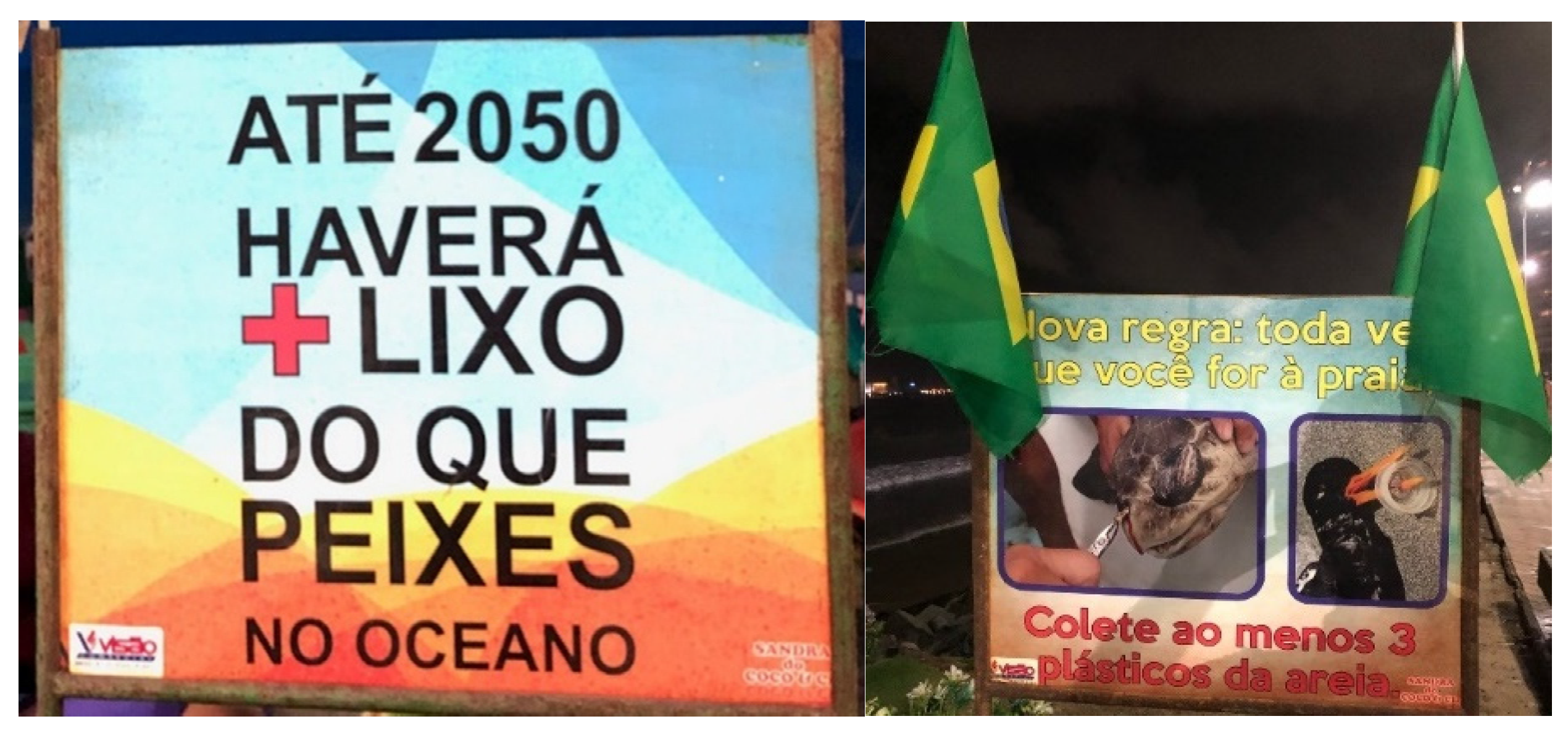
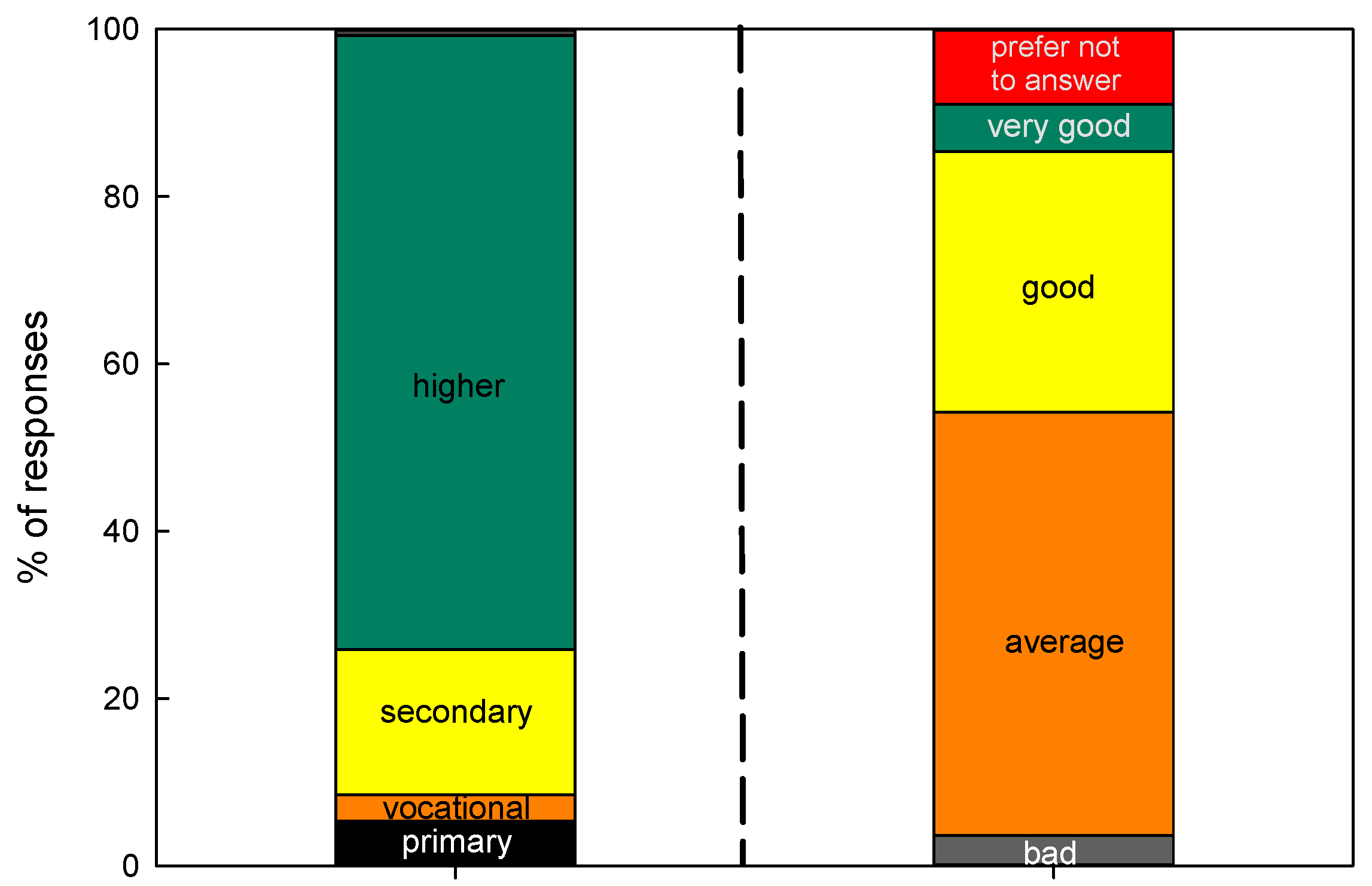
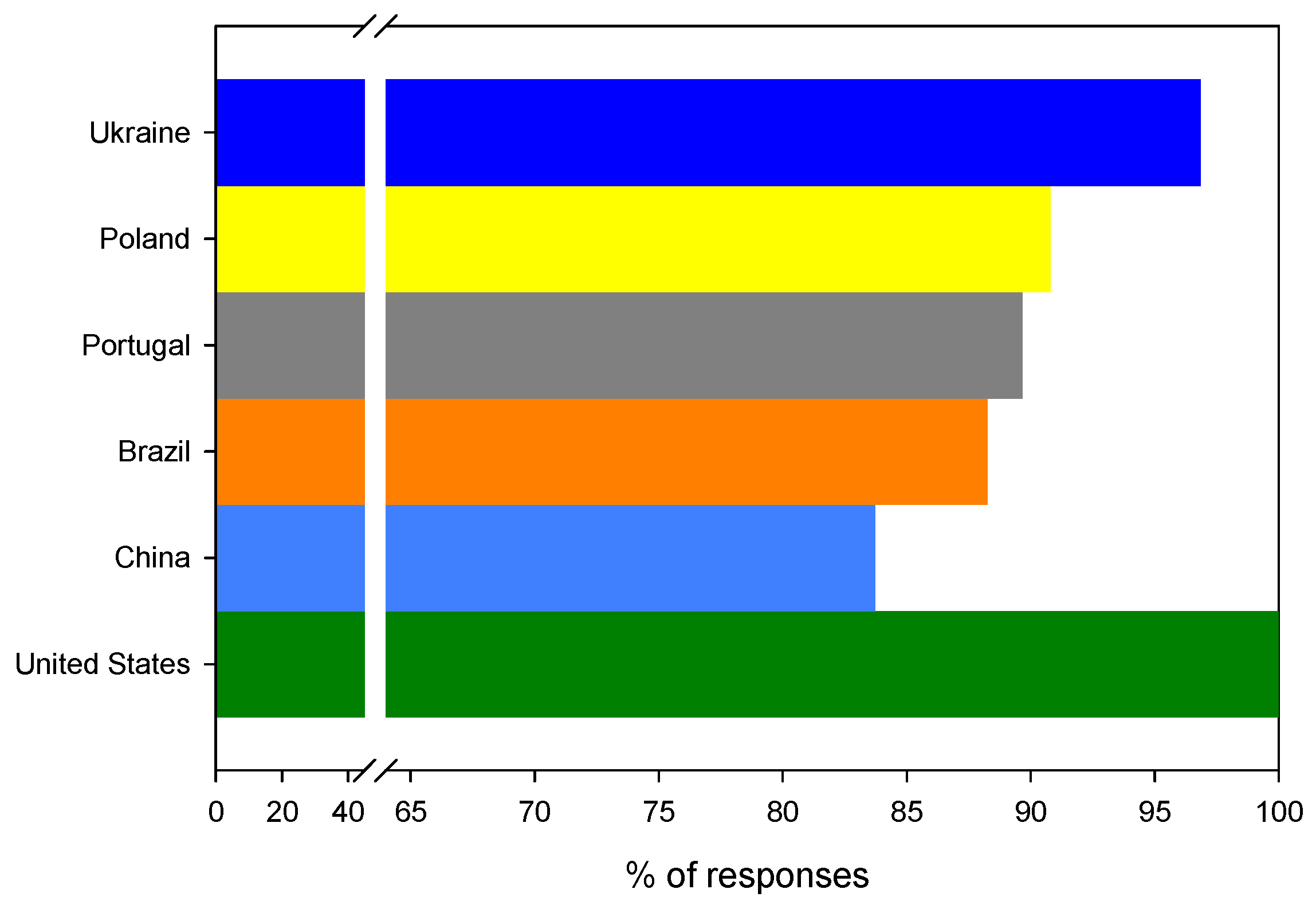

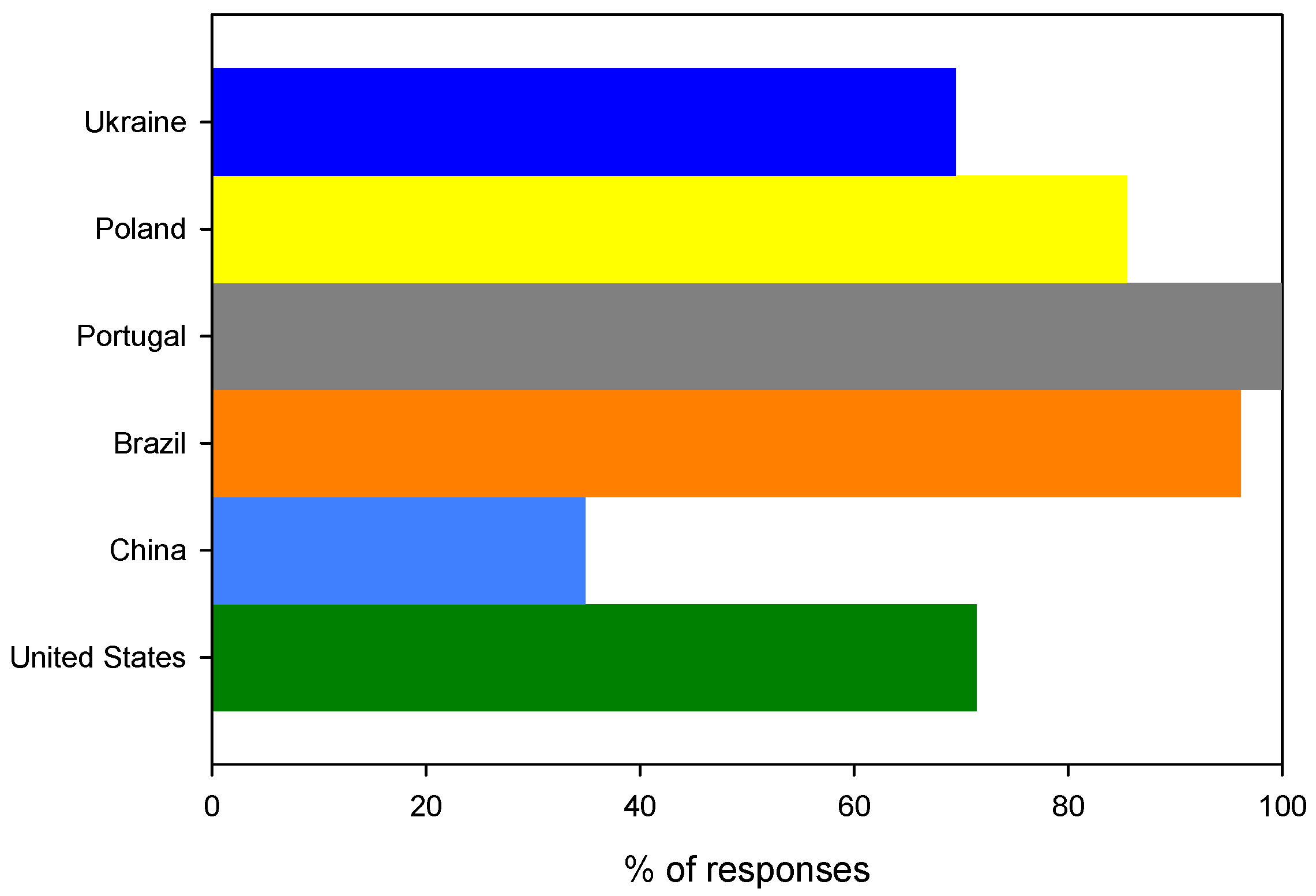
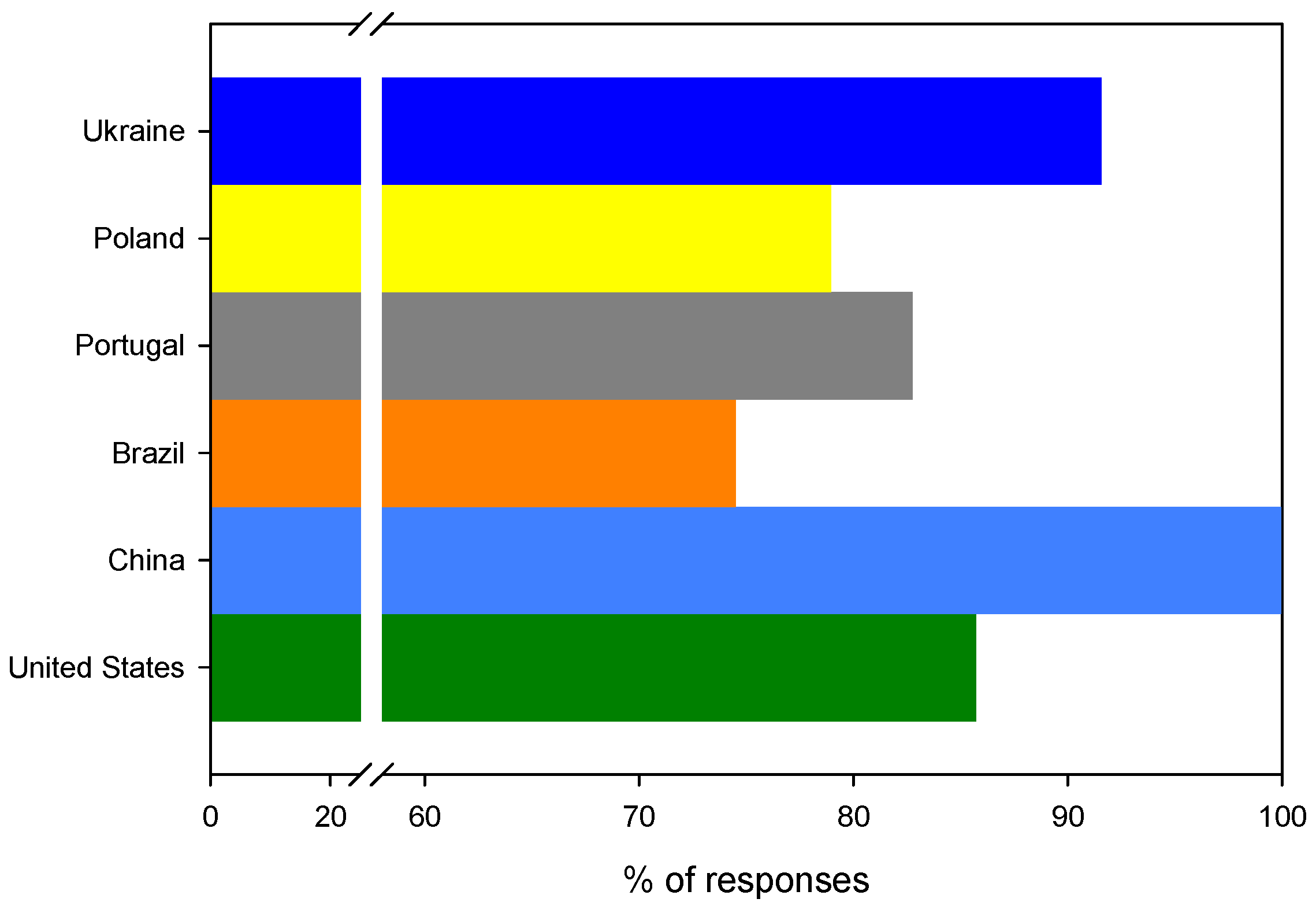
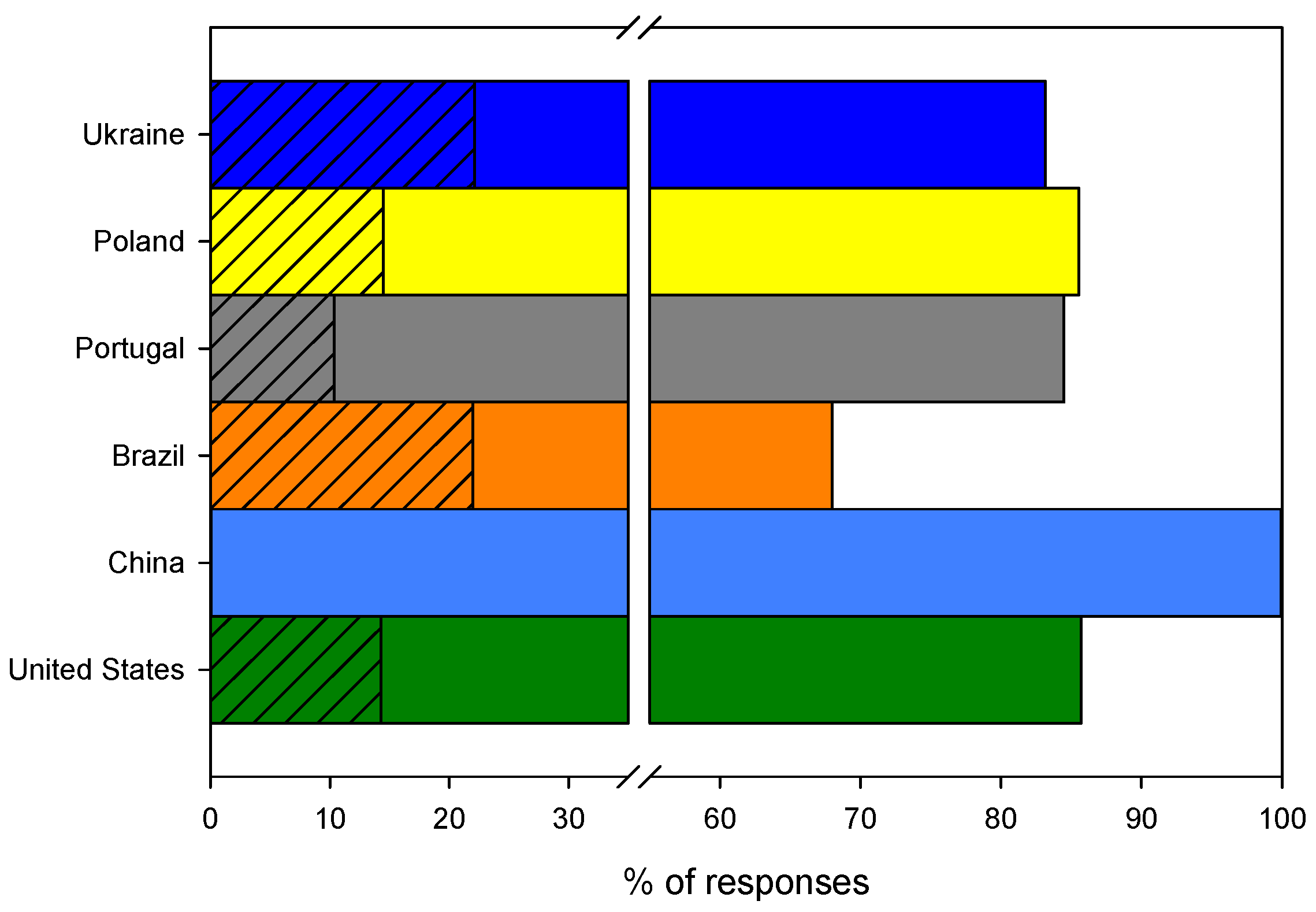
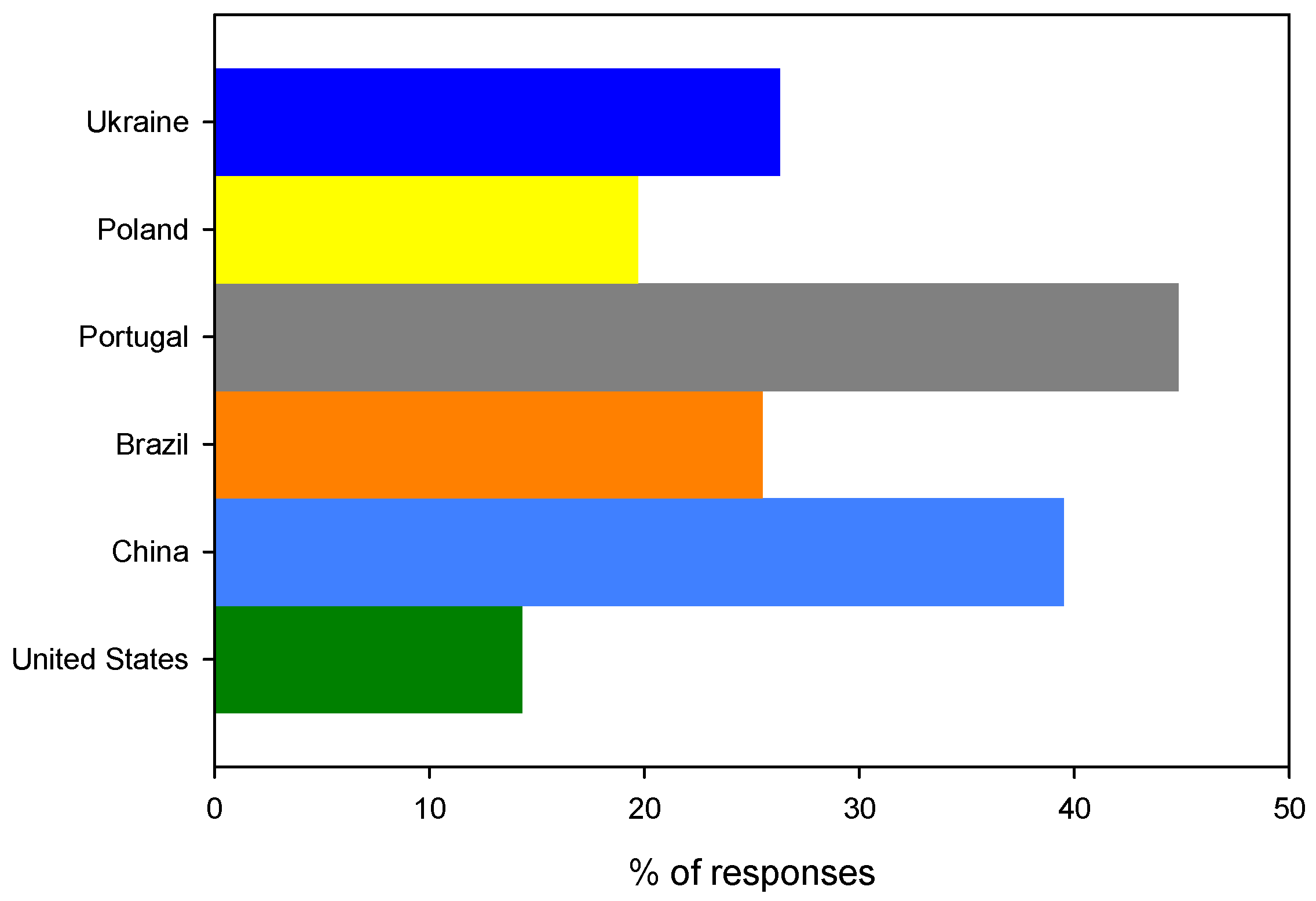

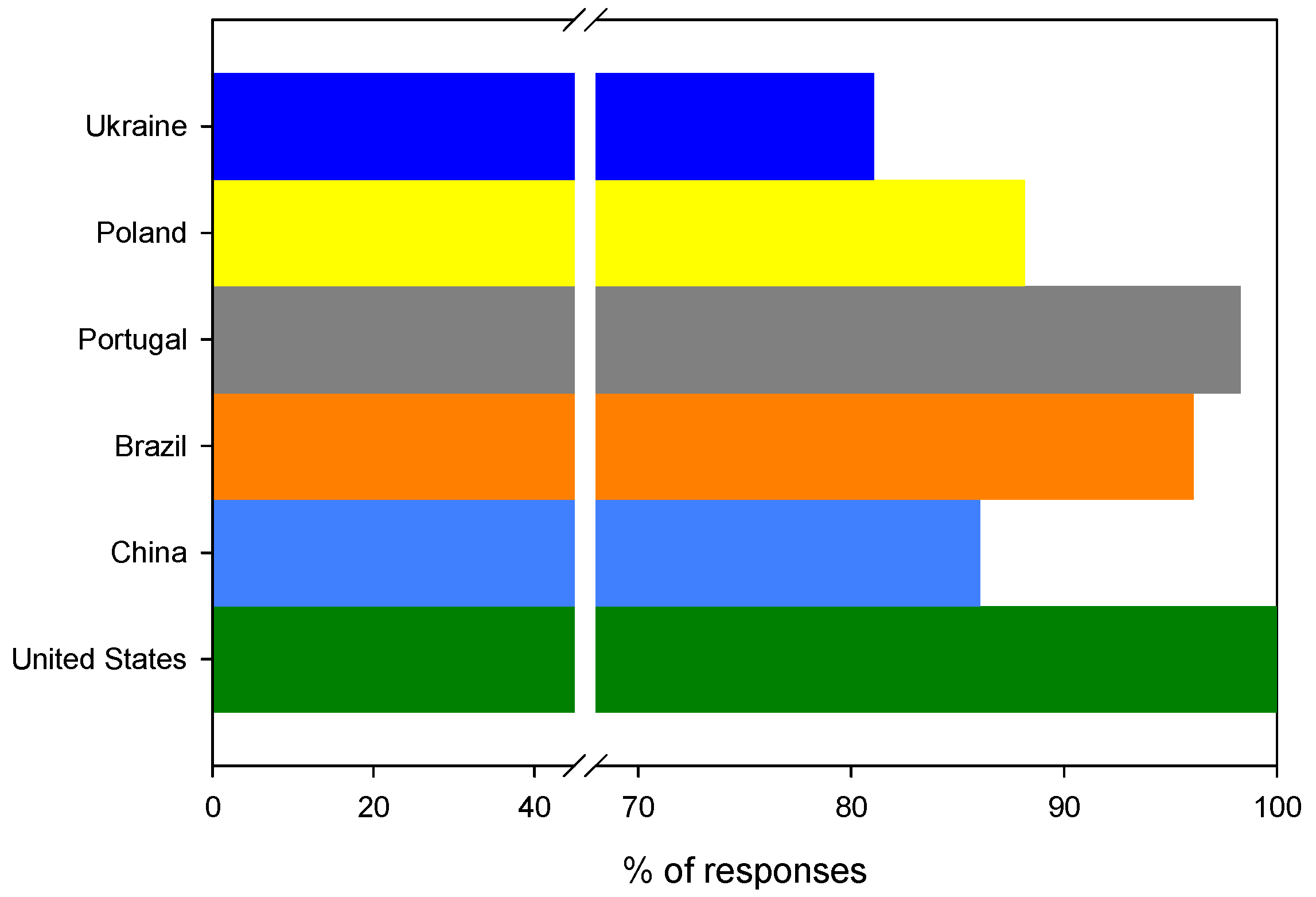
| Question | Answer |
|---|---|
| Gender | Female |
| Male | |
| Other | |
| Prefer not to answer | |
| Age | Under 21 years old |
| 21–64 years old | |
| Over 65 years old | |
| Level of education | Primary |
| Vocational | |
| Secondary | |
| Higher | |
| No answer | |
| Economic status | Very good |
| Good | |
| Average | |
| Bad | |
| Prefer not to answer | |
| Place of residence | Village |
| Town with up to 50,000 inhabitants | |
| City with 50,000 to 150,000 inhabitants | |
| City with 150,000 to 500,000 inhabitants | |
| City with more than 500,000 inhabitants | |
| Who in your household makes purchasing decisions | Mostly me |
| Me and another person | |
| Mostly another person | |
| Are you interested in receiving survey results? If so, please provide your e-mail address. | Free text |
| Country of the questionee | Free text |
| 1. Would you support replacing traditional plastic food packaging with bioplastic packaging? | Yes |
| No | |
| I have no opinion | |
| 2. Did you know that bioplastics can be made from leftover of bakery and confectionery products (e.g., bread, cakes …)? | Yes |
| No | |
| 3. Would it bother you to know that the bioplastic packaging, in which the bread is wrapped, is made of bakery and confectionery leftovers? | Yes |
| No | |
| I have no opinion | |
| 4. Would you expect a clear notice on the bioplastic packaging that will allow you to choose between traditional plastic and biodegradable plastic? | Yes |
| No | |
| I have no opinion | |
| 5. How much more would you be able to pay for a product packed in bioplastic? | Not able to extra cost |
| Below 10% | |
| Between 10% and 20% | |
| Between 20% and 30% | |
| Between 30% and 40% | |
| More than 40% | |
| 6. Did you know that bioplastic can extend the life of a product and preserve its visual and taste properties? | Yes |
| No | |
| 7. Would you share the knowledge about such packaging with others? | Yes |
| No | |
| I have no opinion | |
| 8. Would you encourage others to use modern, environmentally friendly packaging? | Yes |
| No | |
| I have no opinion |
| Country | Questionnaires |
|---|---|
| Ukraine | 95 |
| Poland | 76 |
| Portugal | 58 |
| Brazil | 51 |
| China | 43 |
| USA | 7 |
| Cyprus | 5 |
| Greece | 5 |
| Mexico | 5 |
| Germany | 2 |
| Russia | 2 |
| Finland | 1 |
| The Netherlands | 1 |
| Ireland | 1 |
| Italy | 1 |
| Spain | 1 |
| No country indicated | 37 |
| Place of Residence | Number of Inhabitants |  |  |  |  |  |  | Other Countries | No Country Indicated | Total |
|---|---|---|---|---|---|---|---|---|---|---|
| village | 3 | 14 | 3 | 1 | 2 | 0 | 1 | 6 | 30 | |
| town | <50 k | 5 | 5 | 13 | 4 | 4 | 1 | 3 | 3 | 38 |
| city | 50 k–150 k | 4 | 15 | 12 | 6 | 10 | 1 | 6 | 2 | 56 |
| 150 k–500 k | 42 | 2 | 7 | 13 | 8 | 3 | 2 | 8 | 85 | |
| >500 k | 41 | 40 | 23 | 27 | 19 | 2 | 12 | 18 | 182 |
| Model | β1 | β2 | β3 | Β4 | R2 | Adjusted R2 | |
|---|---|---|---|---|---|---|---|
| Coefficient | 221.98 | −2049.61 | 129.74 | 22.03 | 0.999 | 0.995 | |
| F value | 2472.61 | 995.72 | 6238.98 | 1240.82 | 242.18 | ||
| p-value | 0.015 | 0.020 | 0.008 | 0.018 | 0.041 |
| Model | β1 | β2 | β3 | β4 | R2 | Adjusted R2 | |
|---|---|---|---|---|---|---|---|
| Coefficient | −503.73 | 195.79 | −150.97 | 706.62 | 1.000 | 0.999 | |
| F value | 6327.97 | 3044.93 | 8207.04 | 11,527.27 | 16,469.54 | ||
| p-value | 0.009 | 0.012 | 0.007 | 0.006 | 0.005 |
Publisher’s Note: MDPI stays neutral with regard to jurisdictional claims in published maps and institutional affiliations. |
© 2022 by the authors. Licensee MDPI, Basel, Switzerland. This article is an open access article distributed under the terms and conditions of the Creative Commons Attribution (CC BY) license (https://creativecommons.org/licenses/by/4.0/).
Share and Cite
Kochanska, E.; Wozniak, K.; Nowaczyk, A.; Piedade, P.J.; de Almeida Lavorato, M.L.; Almeida, A.M.; Morais, A.R.C.; Lukasik, R.M. Global Ban on Plastic and What Next? Are Consumers Ready to Replace Plastic with the Second-Generation Bioplastic? Results of the Snowball Sample Consumer Research in China, Western and Eastern Europe, North America and Brazil. Int. J. Environ. Res. Public Health 2022, 19, 13970. https://doi.org/10.3390/ijerph192113970
Kochanska E, Wozniak K, Nowaczyk A, Piedade PJ, de Almeida Lavorato ML, Almeida AM, Morais ARC, Lukasik RM. Global Ban on Plastic and What Next? Are Consumers Ready to Replace Plastic with the Second-Generation Bioplastic? Results of the Snowball Sample Consumer Research in China, Western and Eastern Europe, North America and Brazil. International Journal of Environmental Research and Public Health. 2022; 19(21):13970. https://doi.org/10.3390/ijerph192113970
Chicago/Turabian StyleKochanska, Ewa, Katarzyna Wozniak, Agnieszka Nowaczyk, Patrícia J. Piedade, Marilena Lino de Almeida Lavorato, Alexandre Marcelo Almeida, Ana Rita C. Morais, and Rafal M. Lukasik. 2022. "Global Ban on Plastic and What Next? Are Consumers Ready to Replace Plastic with the Second-Generation Bioplastic? Results of the Snowball Sample Consumer Research in China, Western and Eastern Europe, North America and Brazil" International Journal of Environmental Research and Public Health 19, no. 21: 13970. https://doi.org/10.3390/ijerph192113970
APA StyleKochanska, E., Wozniak, K., Nowaczyk, A., Piedade, P. J., de Almeida Lavorato, M. L., Almeida, A. M., Morais, A. R. C., & Lukasik, R. M. (2022). Global Ban on Plastic and What Next? Are Consumers Ready to Replace Plastic with the Second-Generation Bioplastic? Results of the Snowball Sample Consumer Research in China, Western and Eastern Europe, North America and Brazil. International Journal of Environmental Research and Public Health, 19(21), 13970. https://doi.org/10.3390/ijerph192113970










